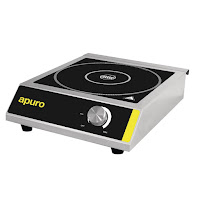The 6 Best Ways to Beat the Kitchen Heat
It's official. 2017 was Australia's hottest ever winter for average maximum temperature. It was also the driest winter in 15 years. Like it or not, temperatures are rising. With summer approaching, what can you do to beat the kitchen heat?
How to Deal with a Hot Kitchen
One of the biggest challenges during a busy service is heat. Pretty much every machine in the kitchen makes heat - ovens, grills, cooktops, sous vide machines and even refrigeration all contribute to higher, more uncomfortable temperatures.It can be a pretty unpleasant experience. Overheating can lead to tiredness, dizziness and nausea, so it's really important to keep both yourself and your kitchen as cool as possible. Here's how.
1. Use Induction
 It's useful to try prevent excess heat being generated in the first place. For example, Induction Cooktop Hobs channel almost all of the energy into the pan instead of the kitchen air. Not only that, induction cooktop hobs are far more efficient, as they only apply power when a pan is in position - making them safer too.
It's useful to try prevent excess heat being generated in the first place. For example, Induction Cooktop Hobs channel almost all of the energy into the pan instead of the kitchen air. Not only that, induction cooktop hobs are far more efficient, as they only apply power when a pan is in position - making them safer too.2. Ventilation
Every professional kitchen should have sufficient ventilation in place, usually in the form of overhead extraction canopies. However, it's possible to improve the airflow throughout your kitchen simply by re-positioning machines so they don't restrict the movement of air. Large freestanding fridges near doors or windows can substantially limit airflow. Likewise, other tall obstructions near fryers can channel hot air and grease away from the extraction. Make sure all the extraction is clear, clean and free from debris.
3. Cook in Advance
If you set up your smartphone for weather alerts (there are loads of free apps that can do this), you should know in plenty of time if severe weather is on it's way. If it's going to be a scorcher, prepping earlier in the day (or even the day before) and then reheating when it's time to serve should prevent excess heat in the kitchen.
A good option for cooking in advance is to seal the food in vacuum bags (use a vacuum pack machine) then cook in a Sous Vide Machine. The food can then be stored in your fridge or freezer, ready to cook whenever you need. Also, remember your Commercial Microwave. It's so easy to forget that reheating with a microwave is fast, economical and doesn't generate much heat.
4. Eco
Regardless of whether a machine is being used or not, if it's switched on it can generate heat. When temperatures are high, it's best to only used the equipment you need to. If no-one is ordering hot drinks, perhaps the Hot Water Urn can be switched off, or at least turned to a lower heat setting. If your machines have an Eco mode, use it.
5. Go Tropical

The hotter your kitchen gets, the harder your refrigeration has to work to keep food cold. If your fridge has to work harder, the internal components get hotter, leading to an endless cycle which could damage your unit. Anything over 32°C on a regular basis and most standard commercial refrigeration could struggle to keep up. Heavy duty Tropical Rated Refrigeration can cope with much hotter kitchens and is usually rated for temperatures between 40-42°C. Look out for the "tropical rated" tag on related products.
6. Wear the Right Kit
One of the easiest things to overlook when trying to keep a cooler kitchen is your Chef Whites. By their nature, chef whites are designed to be hard-wearing - preventing injury from splashing oil and burns.
However, there are chef whites available which are specifically designed for use in a hot commercial kitchen. For example, the Le Chef Staycool jackets are lightweight, breathable and comfortable, whilst still offering the safety and style of more traditional jackets.
By David Evans
“My passion is all things electrical and there’s nothing I like better than getting to grips with the latest industry innovations. When I'm not putting new products through their paces, I’m writing about them.”
Related Reading
Why not check out these other related articles?






0 comments